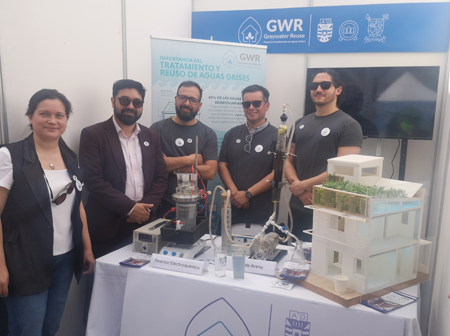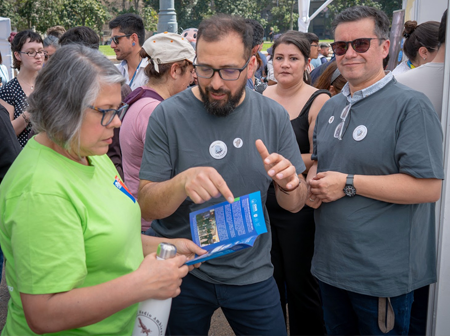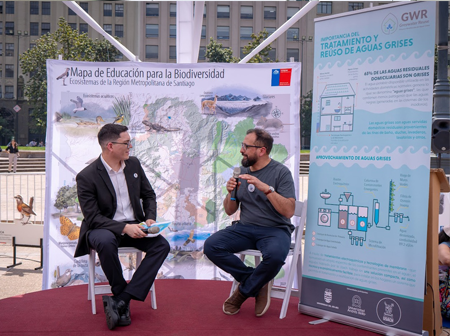You are here
GWR project at the Environmental Fair
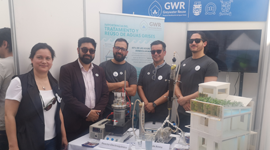
The GWR Project stand was very well received by the public at the 12th Environmental Education Fair, which was held at the Plaza de la Constitución. Notable visitors included the Undersecretary of the Environment, Maximiliano Proaño, and Sonia Reyes, the head of the Regional Ministerial Secretariat for the Environment in the Metropolitan Region. They praised the project's potential to mitigate the country's water crisis and recognized the importance of researchers from different universities collaborating on an environmentally impactful initiative.
Both authorities agreed on the importance of developing strategies to enable better use and care of water in preparation for the challenges posed by climate change.
Undersecretary of the Environment Maximiliano Proaño visited the GWR stand, where he learned about the scope of the initiative. He praised the collaborative, inter-university research efforts.
Visitors to the stand learned about the details of the gray water process and how electrochemical processes and membrane technologies purify wastewater from dishwashers, showers, and sinks so that it can be used for purposes other than consumption. This wastewater does not contain fecal matter, unlike black water from toilets.
Sonia Reyes, the Regional Ministerial Secretary for the Environment for the Metropolitan Region and organizer of the Environmental Fair, talks with Dr. Esteban Quijada, the Director of GWR. Dr. Quijada explains the details of the gray water treatment system that was developed.
Dr. Esteban Quijada, director of the GWR Project, participated in a series of presentations where he discussed the progress of the research.
"It is essential for us to bring the knowledge generated in laboratories to the community. This is a key space for raising public awareness about water scarcity and how technology can address this challenge,” said Dr. Quijada. He also explained how the system works.
Dr. Esteban Quijada, the director of GWR, gave a presentation explaining the domestic graywater treatment system that was developed.
Unlike blackwater, greywater does not contain fecal contamination. This makes it suitable for treatment and reuse in various non-potable activities, such as watering plants, washing cars, and cleaning floors.
A series of processes are required to treat this water and remove common contaminants, such as detergents, soaps, and other chemicals.
Technology is currently in operation.
The system is already installed in a real home and begins with an electrochemical stage that coagulates the main contaminant in gray water: detergents. Then, the water passes through simple commercial filters, producing pretreated water suitable for irrigation. However, the process does not end there. The project also addresses emerging pollutants, such as insecticide or chemical residues, through an additional purification phase. Finally, a reverse osmosis system produces water of excellent quality that is nearly potable, placing this project at the forefront of water reuse technologies.
"Today, we manage to reuse about 75% of the water that enters the house. If we can make it drinkable, we could recirculate almost all the water we consume, which would greatly reduce our drinking water usage,” added Dr. Quijada.
Although the treated water is not intended for human consumption, it is suitable for activities such as watering fruits, vegetables, and plants. The team is conducting ongoing studies and analyses to ensure water quality and explore the possibility of making the water 100% drinkable in the near future.
GWR's participation in the environmental education fair showcased technological innovation and the project's educational focus. Greywater reuse represents significant resource savings and raises awareness about the importance of conserving water, an increasingly scarce resource in Chile.
News
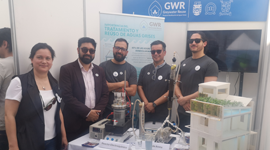 GWR project at the Environmental Fair
GWR project at the Environmental Fair
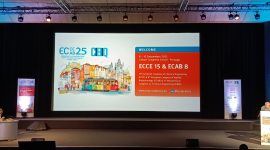 GWR researcher participates in major science conference in Portugal
GWR researcher participates in major science conference in Portugal
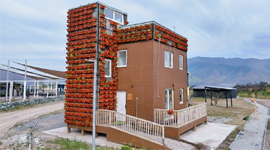 The GWR Project has achieved the technological integration of gray...
The GWR Project has achieved the technological integration of gray...


